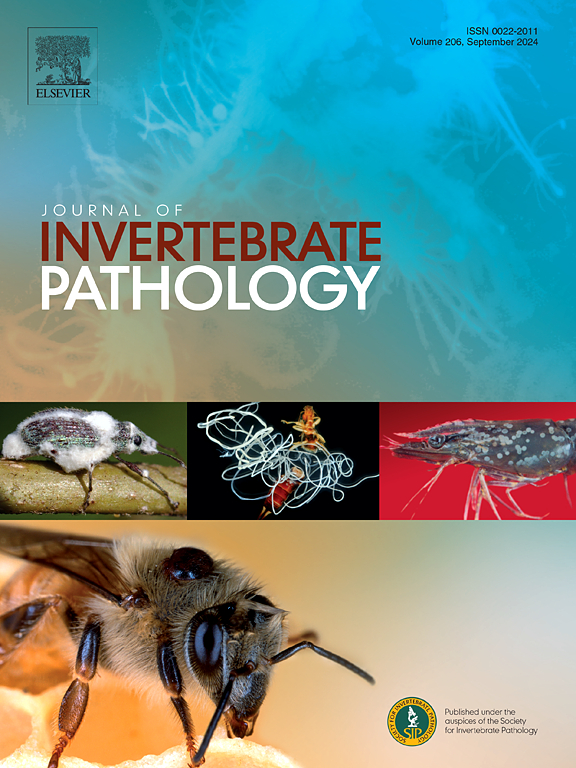黄体小球菌 VKM Ac-2230 对果蝇 S2 细胞先天性免疫的增强激活是由 Relish 介导的。
IF 2.4
3区 生物学
Q1 ZOOLOGY
引用次数: 0
摘要
果蝇免疫反应激活的典型模型表明,IMD途径由革兰氏阴性(革兰氏(-))细菌激活,而Toll途径由革兰氏阳性细菌(革兰氏(+))和真菌激活。然而,这些病原体促进这些途径交叉激活的机制仍然存在争议。此外,S2细胞培养中交叉激活的机制尚未研究。在本研究中,我们研究了两种革兰氏(+)细菌(黄体微球菌和枯草芽孢杆菌)和真菌孢子(绿僵菌)在S2细胞培养中激活IMD通路的作用。用大肠杆菌处理细胞作为对照,以确保IMD通路激活的特异性。我们的研究结果表明,在S2细胞培养中,黄体分枝杆菌显著参与了IMD通路的激活。这可以通过IMD通路依赖基因的显著激活以及作为该通路关键转录因子的津津蛋白的蛋白水解裂解来证明。我们还观察到,佐料对抗菌肽(AMP)基因启动子的强招募,以及对编码肽聚糖识别蛋白(PGRPs)基因的部分招募。此外,靶向佐料的RNA干扰导致所有AMP基因和大多数PGRPs的转录水平显著降低。同样,我们分析了枯草芽孢杆菌和绿僵菌对IMD通路交叉激活的贡献。我们的数据表明枯草芽孢杆菌和金龟子芽孢杆菌也激活了IMD途径,尽管与黄体芽孢杆菌相比,激活程度较低。与此同时,与革兰氏(+)菌相比,真菌孢子对IMD途径激活的影响最小。因此,我们详细研究了S2细胞培养中交叉激活免疫反应的机制,表明佐味可能在诱导果蝇S2细胞的体液免疫反应中起关键作用,主要是针对黄体芽孢杆菌,其次是枯草芽孢杆菌和金银桃芽孢杆菌。本文章由计算机程序翻译,如有差异,请以英文原文为准。

The Enhanced activation of innate immunity in Drosophila S2 cells by Micrococcus luteus VKM Ac-2230 is mediated by Relish
The canonical model of immune response activation in Drosophila suggests that the IMD pathway is activated by Gram-negative (Gram (−)) bacteria, while the Toll pathway is activated by both Gram-positive bacteria (Gram (+)) and fungi. However, the mechanisms by which these pathogens promote cross-activation of these pathways remain controversial. In addition, the mechanisms of cross-activation in S2 cell culture remain unstudied. In this study, we investigated the role of two Gram (+) bacteria (Micrococcus luteus and Bacillus subtilis) and fungal spores (Metarhizium anisopliae) in activating the IMD pathway in S2 cell cultures. Cells were treated with Escherichia coli as a control to ensure the specificity of IMD pathway activation. Our results demonstrated a significant involvement of M. luteus in the activation of the IMD pathway in S2 cell cultures. This is evidenced by the marked activation of IMD pathway-dependent genes, as well as the proteolytic cleavage of the Relish protein, which serves as a key transcription factor for this pathway. We also observed a strong recruitment of Relish to the promoters of antimicrobial peptide (AMP) genes, along with a partial recruitment to the genes encoding peptidoglycan recognition proteins (PGRPs). Furthermore, RNA interference targeting Relish resulted in a significant reduction in the transcription levels of all AMP genes and most PGRPs. Similarly, we analyzed the contributions of B. subtilis and M. anisopliae to the cross-activation of the IMD pathway. Our data indicate that both B. subtilis and M. anisopliae also activate the IMD pathway, albeit to a lesser extent compared to M. luteus. At the same time, fungal spores exhibited minimal influence on the activation of the IMD pathway when compared to Gram (+) bacteria. Thus, we have investigated in detail the mechanisms of cross-activation of the immune response in S2 cell culture, suggesting that Relish may play a critical role in inducing a humoral immune response in Drosophila S2 cells, primarily against M. luteus and to a lesser extent against B. subtilis and M. anisopliae.
求助全文
通过发布文献求助,成功后即可免费获取论文全文。
去求助
来源期刊
CiteScore
6.10
自引率
5.90%
发文量
94
审稿时长
1 months
期刊介绍:
The Journal of Invertebrate Pathology presents original research articles and notes on the induction and pathogenesis of diseases of invertebrates, including the suppression of diseases in beneficial species, and the use of diseases in controlling undesirable species. In addition, the journal publishes the results of physiological, morphological, genetic, immunological and ecological studies as related to the etiologic agents of diseases of invertebrates.
The Journal of Invertebrate Pathology is the adopted journal of the Society for Invertebrate Pathology, and is available to SIP members at a special reduced price.

 求助内容:
求助内容: 应助结果提醒方式:
应助结果提醒方式:


